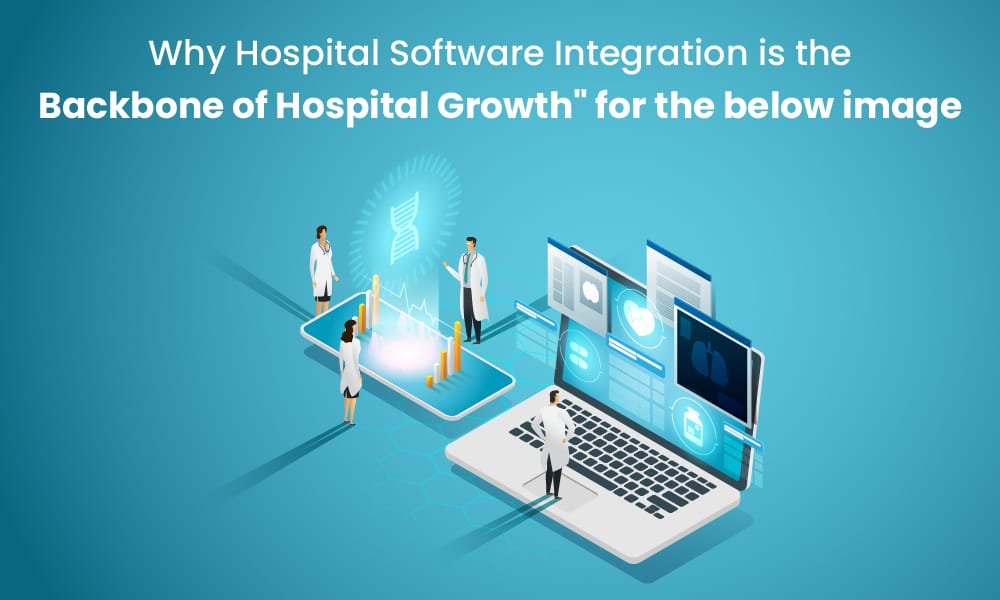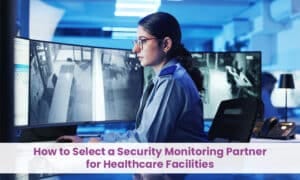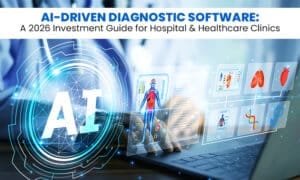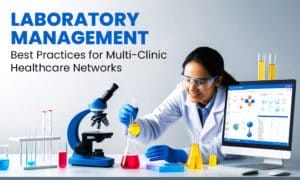
Hospitals today operate in a high-pressure environment where patient expectations, compliance demands, and competition continuously increase. To thrive, healthcare organisations must adopt hospital software that not only streamlines operations but also integrates seamlessly across every function. Unfortunately, fragmented systems often slow processes, create errors, and limit growth.
By implementing the best hospital management software with AI-driven capabilities, hospitals eliminate inefficiencies, improve compliance, and create a unified care experience. Success now depends on scalable hospital software solutions that bring together patient records, billing, diagnostics, and compliance under one intelligent ecosystem. In this blog, we outline why seamless integrations are the backbone of hospital growth, how they ensure accreditation readiness, and which top software integrations for hospitals and clinics drive the most impact worldwide.

Why Seamless Integrations Are Vital for Hospital Success
Hospitals cannot thrive with disconnected systems that slow workflows, create errors, and increase compliance risks. Seamless integrations unify operations, improve care delivery, and ensure accreditation readiness. By leveraging advanced hospital solutions with AI-driven interoperability, healthcare organisations set the foundation for sustainable growth.
• Breaking Down Data Silos
Healthcare data often gets trapped in isolated systems such as EHR, billing, labs, and imaging. These silos create inefficiencies that impact both patient care and revenue. With fully integrated medical software systems, hospitals centralise all critical data, making it accessible in real-time to physicians, nurses, and administrators. This not only improves accuracy but also eliminates duplication, ensures faster decision-making, and drives collaborative care across departments.
• Enhancing Patient-Centred Care
Patients today expect convenience, personalisation, and accuracy in every interaction. Integrated hospital software provides a unified patient record that includes medical history, prescriptions, diagnostic reports, and financial data.
Physicians use this holistic view to create tailored treatment plans. When hospitals adopt the best hospital management system with AI integrations, they go beyond clinical efficiency and deliver experiences that build loyalty, improve outcomes, and enhance patient trust in the hospital’s brand.
• Driving Operational Efficiency
Operational inefficiencies directly affect hospital profitability and staff morale. Manual processes in scheduling, prescription management, and billing consume valuable time. Seamless integrations automate these workflows, allowing hospitals to reallocate resources toward patient care and innovation. By deploying scalable hospital software solutions, leadership reduces bottlenecks, improves staff productivity, and unlocks opportunities for strategic growth without increasing costs.
• Meeting Global Compliance Standards (NABH, ISO, HIPAA)
Regulatory compliance stands as one of the most resource-intensive areas in healthcare. Hospitals need accurate, traceable, and standardised data to achieve and maintain accreditation.
NABH compliant software, HIMS for ISO standards, and compliance-ready HIMS help hospitals meet stringent quality benchmarks while reducing audit-related stress. With NABH audit hospital tools, administrators monitor compliance continuously, generate real-time reports, and ensure hospitals remain fully prepared for inspections, safeguarding reputation and patient trust.
• Powering Growth Through AI and Analytics
Hospitals must look beyond today’s demands and prepare for tomorrow’s challenges. AI-powered integrations bring predictive intelligence into daily operations. From forecasting patient admissions and optimising bed utilisation to preventing emergency room congestion, analytics provide actionable insights. With scalable hospital software solutions enriched with AI, hospitals gain the ability to expand services, improve decision-making, and drive sustainable growth in a competitive healthcare environment.

Advantages of AI-Powered Hospital Software Integrations
AI-powered integrations transform hospitals into intelligent ecosystems that drive efficiency, compliance, and growth. By combining automation with smart analytics, hospitals can eliminate operational bottlenecks, enhance patient care, and strengthen regulatory readiness.
These integrations empower decision-makers with real-time insights while reducing costs and improving scalability. Ultimately, the adoption of AI-driven hospital solutions ensures that every department—from clinical to administrative—operates in perfect harmony, enabling hospitals to deliver care with precision and confidence.
• Real-Time Decision Support
AI-driven interoperability gives physicians a comprehensive view of patient records, diagnostic reports, and vitals within seconds. Instead of switching between multiple platforms, doctors access a unified dashboard that enhances speed and accuracy in clinical decisions.
This capability reduces diagnostic delays, minimises medical errors, and enables personalised treatment planning. In fast-paced healthcare environments, real-time decision support ensures that every patient receives timely, evidence-based care while enabling administrators to track clinical performance and compliance seamlessly.
• Faster Interoperability Between Systems
Hospitals often struggle with fragmented systems that operate in silos. AI-powered integrations in medical software systems bridge these gaps, allowing radiology, laboratory, and pharmacy departments to exchange data instantly. Physicians can order tests, view imaging results, and prescribe medications without delays or manual intervention. This interoperability streamlines patient journeys from admission to discharge while boosting operational efficiency. By ensuring departments function as one, hospitals eliminate redundant processes and create a smooth, coordinated healthcare experience for patients.
• Improved Patient Trust and Satisfaction
Patient trust depends on accuracy, speed, and transparency in care delivery. AI-powered integrations within the best hospital management software ensure error-free prescriptions, seamless billing, and faster access to results.
Patients no longer face delays, repeated tests, or administrative hassles. Instead, they benefit from a consistent and professional experience across touchpoints. This reliability strengthens hospital reputation, encourages repeat visits, and drives positive word-of-mouth referrals. By enhancing patient satisfaction, hospitals secure both long-term loyalty and competitive advantage.
• Cost Optimisation
Financial sustainability remains a key priority for every healthcare organisation. AI-driven integrations automate repetitive administrative tasks, eliminate duplicate data entry, and minimise human errors in billing and claims. This reduces overhead costs, accelerates revenue cycles, and prevents claim rejections.
With accurate financial data flowing seamlessly between departments, hospitals optimise resource allocation and improve profitability. By cutting waste and increasing operational efficiency, scalable hospital solutions empower hospitals to deliver quality care while maintaining financial resilience.
• Scalable and Future-Proof
Healthcare needs evolve constantly, and hospitals must adopt solutions that can grow alongside them. Scalable hospital software solutions with AI-powered integrations allow facilities to expand services, integrate telemedicine platforms, and adopt future-ready modules without costly replacements.
This flexibility ensures that hospitals remain agile in adapting to new technologies, regulations, and patient demands. By choosing systems that accommodate growth, hospitals protect their investments and prepare for long-term success in a rapidly changing digital healthcare landscape.
10 Must-Have Hospital Software Integrations
Seamless integrations define the strength of modern hospital software. Without them, hospitals face data silos, inefficiencies, and compliance risks. By adopting the best hospital management software with AI-powered interoperability, hospitals unify operations, improve compliance, and enhance patient experiences. Below are the top software integrations for hospitals and clinics that ensure scalability, efficiency, and sustainable growth.
1. Electronic Health Record (EHR) Integration
EHR integration forms the backbone of hospital operations. It centralises patient data, ensuring doctors, nurses, and administrators access accurate information instantly. This integration eliminates duplicate tests, prevents clinical errors, and enhances collaboration across departments.
With AI-enabled features, hospitals track patient histories, treatments, and prescriptions in real-time. A unified EHR strengthens continuity of care and builds trust with patients. For leadership, this integration also improves compliance reporting, streamlines audits, and provides a reliable digital foundation for expanding healthcare services with scalable hospital software solutions.
2. Laboratory Information System (LIS) Integration
Diagnostic efficiency relies heavily on LIS integration. By connecting labs with medical software systems, hospitals automate test requests, manage sample tracking, and deliver reports directly to physicians. This reduces turnaround time and minimises human errors. AI-powered LIS modules can even detect abnormal results for early alerts.
Such integration enhances transparency, supports compliance, and improves patient satisfaction. Hospitals save significant time and resources while ensuring clinical teams receive accurate data in real-time. LIS integration is no longer a choice but a necessity for hospitals aiming to build reputation, compliance-readiness, and operational excellence globally.
3. Radiology/PACS Integration
Imaging plays a critical role in patient diagnosis. PACS (Picture Archiving and Communication System) integration enables physicians to access scans, reports, and radiology images anytime, across multiple devices. AI-enhanced imaging further improves diagnostic accuracy by highlighting anomalies that may otherwise go unnoticed.
Hospitals gain a competitive edge with faster reporting, improved collaboration between radiologists and specialists, and efficient storage of medical images. This integration also streamlines compliance with medical imaging standards, ensuring traceable, auditable records. Radiology/PACS integration transforms hospital workflows by making diagnostic insights instantly available, enhancing patient care, and supporting global accreditation requirements.
4. Pharmacy Management Integration
Pharmacy management integration safeguards patient safety and improves efficiency. By connecting pharmacies with the best hospital management system with AI integrations, hospitals ensure prescriptions are accurate, inventory levels are updated in real-time, and drug interactions are monitored automatically.
AI-driven alerts prevent stockouts and overstocking while compliance modules track expiry dates and safety regulations. This integration empowers pharmacists, doctors, and administrators to collaborate effectively, reducing delays and errors. Automated reorder systems maintain supply chain continuity. For patients, this translates into timely medication access, while for hospitals it enhances compliance, cost control, and operational trustworthiness.
5. Billing & Revenue Cycle Management Integration
Revenue leakage threatens hospital profitability. Billing and revenue cycle management integration ensures claims are accurate, timely, and compliant. Hospitals automate insurance verification, coding, invoicing, and payment tracking through hospital software. This eliminates errors, reduces denials, and accelerates reimbursements.
Administrators gain transparent financial dashboards that support smarter decision-making. AI-powered systems can predict claim bottlenecks and optimise revenue flows. For compliance, this integration creates traceable financial records aligned with NABH and ISO standards. Hospitals not only protect revenue but also improve financial trust with insurers and patients, ensuring long-term sustainability and stronger market positioning.
6. Telemedicine & Virtual Care Integration
Telemedicine has become essential for global healthcare expansion. Integrating telemedicine within scalable hospital software solutions enables remote consultations, AI-powered triage, and virtual patient monitoring. Patients gain access to care beyond geographical boundaries, while hospitals expand services without physical infrastructure constraints.
Integration ensures scheduling, documentation, billing, and prescriptions flow seamlessly across physical and virtual care channels. For administrators, telemedicine integration strengthens scalability, compliance readiness, and data security. Hospitals that adopt virtual care modules establish themselves as innovative leaders, offering convenient patient-centred experiences while meeting modern expectations for accessible and affordable healthcare delivery.
7. Asset & Inventory Management Integration
Hospitals manage thousands of critical assets, from ventilators to surgical kits. Asset and inventory management integration prevents losses, minimises downtime, and ensures optimal utilisation. By linking with medical software systems, hospitals track equipment usage, maintenance schedules, and consumable levels automatically.
AI-driven analytics predict replacement timelines, reducing unexpected failures. This integration supports compliance by providing traceable records of equipment calibration and safety checks. It also prevents stock shortages and avoids overspending on unused inventory. Asset management integration protects investments, improves efficiency, and ensures hospitals remain audit-ready while delivering uninterrupted, quality care.
8. Compliance & Accreditation Integration
Compliance forms the foundation of hospital credibility. Integrating hospital accreditation software, NABH compliant software, and HIMS for ISO standards automates compliance tracking, audit readiness, and reporting. Hospitals eliminate manual paperwork and gain real-time alerts on non-compliance. NABH audit hospital tools ensure administrators monitor quality parameters continuously.
This integration reduces risks during inspections, builds patient trust, and strengthens reputation. AI-driven compliance dashboards streamline accreditation renewals and keep hospitals aligned with evolving standards. Compliance integration positions hospitals as reliable healthcare providers globally while enabling them to expand services with confidence and long-term credibility.
9. Patient Engagement & CRM Integration
Patient engagement defines hospital reputation. CRM integration within hospital solutions ensures that patients receive timely reminders, follow-up messages, and personalised care communication. Hospitals improve loyalty by offering seamless appointment scheduling, post-treatment follow-ups, and transparent communication channels.
AI-powered CRM systems analyse patient behaviour, predict preferences, and enable customised engagement strategies. This integration helps hospitals reduce no-shows, improve retention, and strengthen community trust. With compliance-ready features, CRM systems ensure that sensitive patient interactions remain secure. Hospitals that adopt CRM integration position themselves as patient-first providers while also building long-term revenue opportunities through stronger patient relationships.
10. AI-Driven Analytics & Business Intelligence Integration
Data-driven decision-making ensures hospital growth. Integrating BI dashboards within compliance-ready HIMS provides leaders with real-time insights into revenue, bed utilisation, staff productivity, and patient flow. Predictive analytics anticipates demand patterns, enabling hospitals to prepare resources effectively.
AI-driven integration identifies inefficiencies, supports compliance reporting, and highlights areas for cost savings. Administrators make informed, data-backed decisions, improving scalability and growth. Hospitals gain competitive advantages by forecasting trends, aligning with accreditation requirements, and delivering measurable patient care improvements. Business intelligence integration transforms hospitals from reactive organisations into proactive, future-ready institutions.
The Future: AI-Powered Seamless Ecosystems in Healthcare
The future of healthcare lies in creating fully connected and intelligent ecosystems where every function, department, and stakeholder works in perfect synchronisation. Hospitals will no longer depend on fragmented platforms; instead, they will rely on scalable hospital software solutions that integrate seamlessly with wearable devices, remote monitoring systems, and AI-driven diagnostic tools. These integrations allow real-time patient tracking, predictive insights, and faster decision-making, ensuring hospitals remain competitive and patient-focused.
Adopting NABH-compliant software will remain critical to meeting evolving regulatory requirements and maintaining accreditation standards. At the same time, the best hospital management software will act as the operational backbone, driving efficiency in clinical workflows, billing, inventory, and compliance processes. When hospitals implement the best hospital management system with AI integrations, they not only streamline operations but also elevate care delivery, build trust with patients, and achieve consistent growth.
The shift toward AI-powered ecosystems will redefine healthcare excellence. Hospitals that integrate advanced medical software systems with compliance-ready tools will establish themselves as leaders in both patient outcomes and regulatory adherence. By embracing AI, predictive analytics, and smart integrations, tomorrow’s hospitals will operate as proactive, patient-centric organisations that deliver quality care, ensure continuous compliance, and secure long-term sustainability in a competitive global market.

Integrations Are the True Backbone of Hospital Growth
Hospitals cannot achieve long-term growth with fragmented systems. Seamless integrations transform care delivery, strengthen compliance, and increase profitability. By adopting hospital accreditation software, NABH audit hospital tools, and compliance-ready HIMS, hospitals secure sustainable growth. With scalable hospital solutions that integrate AI, compliance, and patient engagement, hospitals prepare for the future with confidence.





